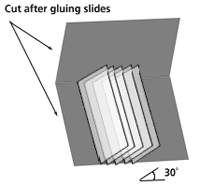Polarized Light
Required Materials
Two polarizers (small dark rectangles)
A prism
A flashlight
Activity Directions
- Look at a light source with both polarizers held together. Rotate one and notice the transmitted light intensity decrease. Maximum decrease is when the polarizers are at 90° — crossed polarizers.
- Look through one polarizer at the image of the sun; reflected from a glass surface. Rotate the polarizer and note the intensity change.
- Look through one polarizer at a flashlight and note that the flashlight source is not polarized (no change in intensity as the polarizer is rotated). Then look at the flashlight beam reflected off a glass surface and rotate the polarizer. A portion of the reflected light is polarized.
- Most light sources are unpolarized except for sunlight reflected off water.
- Hold two polarizers side by side at 90° to each other. Rotate the pair and compare the variations in transmitted intensity.
- If you have a laser pointer, aim the laser at a wall or paper, place the polarizer over the laser head and rotate it. In one orientation the beam intensity almost vanishes.
- Can you find any other examples?
- Look through two crossed polarizers with a stretchable piece of plastic between them. Pull the plastic holding one end. You will see an increase in transmission and even colors because the plane of polarization rotates as it passes through the plastic.
- You can make your own polarizers with 5 or so microscope slides and some heavy-weight, dark-colored (to minimize reflection) construction paper. Cut a strip of paper about 4" long and as wide as your microscope slide. Tape this at right angles to the sheet of construction paper as it will be the shelf for the slides. Put glue on the long bottom and one end of the slide and place it at a slant so that light incident will be at the Brewster angle. The Brewster angle is 56° for light in air incident on glass. We can approximate this by 60° and slant the slides so that the incident light is 60° from the normal. Put 5 or 6 slides in a slanted position and cut the top and side covers from the construction paper and you have made a polarizing filter.

Want to Learn More? Read an article related to this activity:









